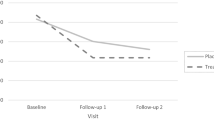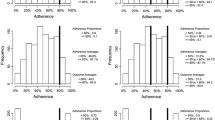Abstract
Interventions aimed at improving HIV medication adherence could be dismissed as ineffective due to statistical methods that are not sufficiently sensitive. Cross-sectional techniques such as t tests are common to the field, but potentially inaccurate due to increased risk of chance findings and invalid assumptions of normal distribution. In a secondary analysis of a randomized controlled trial, two approaches using logistic generalized estimating equations (GEE)—planned contrasts and growth curves—were examined for evaluating percent adherence data. Results of the logistic GEE approaches were compared to classical analysis of variance (ANOVA). Robust and bootstrapped estimation was used to obtain empirical standard error estimates. Logistic GEE with either planned contrasts or growth curves in combination with robust standard error estimates was superior to classical ANOVA for detecting intervention effects. The choice of longitudinal model led to key differences in inference. Implications and recommendations for applied researchers are discussed.
Resumen
Las intervenciones con el propósito de mejorar la toma de medicamentos para el VIH podrían ser estimadas como ineficaces debido a métodos estadísticos que no son suficientemente sensitivos. Las técnicas transversales tal como la prueba t son comunes en el estudio de campo, pero potencialmente inexactas debido a un aumento del riesgo en los resultados por la casualidad y las suposiciones incorrectas en la distribución normal. A través de un análisis secundario de una prueba controlada aleatoria, fue examinado para evaluar adherencia como porcentaje, el método de la ecuación de estimación generalizada (GEE) logística, a través de dos especificaciones: los contrastes planeados y las curvas de crecimiento. Los resultados de ambas especificaciones fueron comparados con el análisis de la varianza (ANOVA) clásico. La estimación robusta y el bootstrapping fueron usados para obtener cálculos empíricos de error estándar. La GEE logística con estimación robusta, ya sea con contrastes planeados o curvas de crecimiento, fue superior al ANOVA clásico. La elección de método longitudinal produjo diferencias claves con respecto a la inferencia. Las implicaciones y recomendaciones para investigadores aplicados son discutidas.

Similar content being viewed by others
References
Frison L, Pocock S. Repeated measures in clinical trials: analysis using mean summary statistics and its implications for design. Stat Med. 1992;11(13):1685–704.
Mills E, Wu P, Gagnier J, Devereaux P. The quality of randomized trial reporting in leading medical journals since the revised CONSORT statement. Contemp Clin Trials. 2005;26(4):480–7.
Fairclough DL. Design and analysis of quality of life studies in clinical trials. 2nd ed. Boca Raton: CRC Press; 2010.
Pocock S, Hughes M, Lee R. Statistical problems in the reporting of clinical trials. A survey of three medical journals. N Engl J Med. 1987;317(7):426–32.
Diggle P, Heagerty P, Liang K-Y, Zeger SL. Analysis of longitudinal data. 2nd ed. New York: Oxford University Press; 2002.
Price M, Anderson P, Henrich CC, Rothbaum BO. Greater expectations: using hierarchical linear modeling to examine expectancy for treatment outcome as a predictor of treatment response. Behav Ther. 2008;39(4):398–405.
Simoni JM, Kurth AE, Pearson CR, Pantalone DW, Merrill JO, Frick PA. Self-report measures of antiretroviral therapy adherence: a review with recommendations for HIV research and clinical management. AIDS Behav. 2006;10(3):227–45.
Streiner DL. Breaking up is hard to do: the heartbreak of dichotomizing continuous data. Can J Psychiatry. 2002;47(3):262–6.
Huber P. Robust statistics. New York: Wiley; 1981.
Efron B, Tibshirani RJ. An introduction to the bootstrap. New York: Chapman & Hall; 1997.
DeMaris A. A tutorial in logistic regression. J Marriage Fam. 1995;57:956–68.
Papke LE, Wooldridge JM. Panel data methods for fractional response variables with an application to test pass rates. J Econom. 2008;145(1–2):121–33.
Simoni JM, Pearson CR, Pantalone DW, Marks G, Crepaz N. Efficacy of interventions in improving highly active antiretroviral therapy adherence and HIV-1 RNA viral load: a meta-analytic review of randomized controlled trials. J Acquir Immune Defic Syndr. 2006;43(Suppl 1):S23–35.
Rosenthal JA. Qualitative descriptors of strength of association and effect size. J Soc Serv Res. 1996;21(4):37–59.
Goujard C, Bernard N, Sohier N, Peyramond D, Lançon F, Chwalow J, et al. Impact of a patient education program on adherence to HIV medication: a randomized clinical trial. J Acquir Immune Defic Syndr. 2003;34(2):191–4.
Rigsby MO, Rosen MI, Beauvais JE, Cramer JA, Rainey PM, O’Malley SS, et al. Cue-dose training with monetary reinforcement: pilot study of an antiretroviral adherence intervention. J Gen Intern Med. 2000;15(12):841–7.
Weber R, Christen L, Christen S, Tschopp S, Znoj H, Schneider C, et al. Effect of individual cognitive behaviour intervention on adherence to antiretroviral therapy: prospective randomized trial. Antivir Ther. 2004;9(1):85–95.
Simoni JM, Huh D, Frick PA, Pearson CR, Andrasik MP, Dunbar PJ, et al. Peer support and pager messaging to promote antiretroviral modifying therapy in Seattle: a randomized controlled trial. J Acquir Immune Defic Syndr. 2009;52(4):465–73
Papke LE, Wooldridge JM. Econometric methods for fractional response variables with an application to 401 (k) plan participation rates. J Appl Econom. 1996;11(6):619–32.
Chesney MA, Ickovics JR, Chambers DB, Gifford AL, Neidig J, Zwickl B, et al. Self-reported adherence to antiretroviral medications among participants in HIV clinical trials: the AACTG adherence instruments. AIDS Care. 2000;12(3):255–66.
StataCorp LP. Stata Statistical Software: release 11. College Station: Stata Corporation; 2009.
McAlister FA, Straus SE, Sackett DL, Altman DG. Analysis and reporting of factorial trials: a systematic review. JAMA. 2003;289(19):2545–53.
Liang K-Y, Zeger SL. Longitudinal data analysis using generalized linear models. Biometrika. 1986;73(1):13–22.
Raudenbush SW, Bryk AS. Hierarchical linear models: applications and data analysis methods. Thousand Oaks: Sage; 2002.
Rogers WH. Regression standard errors in clustered samples. Stata Tech Bull. 1993;13:19–23.
Williams RL. A note on robust variance estimation for cluster-correlated data. Biometrics. 2000;56(2):645–6.
Schafer JL. Multiple imputation: a primer. Stat Methods Med Res. 1999;8(1):3–15.
Schafer JL. Analysis of incomplete multivariate data. New York: Chapman & Hall; 1997.
Rubin DB. Multiple imputation for nonresponse in surveys. New York: Wiley; 1987.
Pearson C, Simoni J, Hoff P, Kurth A, Martin D. Assessing antiretroviral adherence via electronic drug monitoring and self-report: an examination of key methodological issues. AIDS Behav. 2007;11(2):161–73.
Cohen J. The earth is round (P < 0.05). Am Psychol. 1994;49(12):997–1003.
Acknowledgment
This research was supported by a National Institute of Mental Health Grant (R01 MH58986) to Jane M. Simoni, Ph.D.
Author information
Authors and Affiliations
Corresponding author
Electronic supplementary material
Below is the link to the electronic supplementary material.
Rights and permissions
About this article
Cite this article
Huh, D., Flaherty, B.P. & Simoni, J.M. Optimizing the Analysis of Adherence Interventions Using Logistic Generalized Estimating Equations. AIDS Behav 16, 422–431 (2012). https://doi.org/10.1007/s10461-011-9955-5
Published:
Issue Date:
DOI: https://doi.org/10.1007/s10461-011-9955-5




